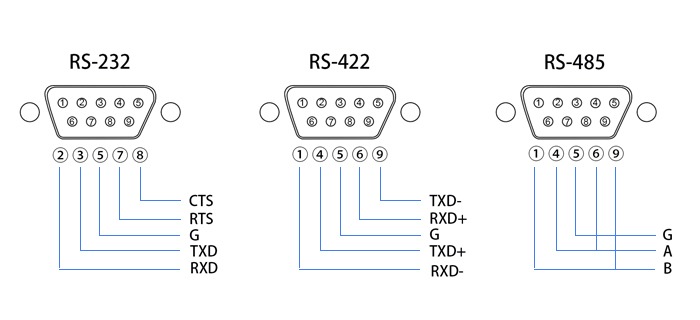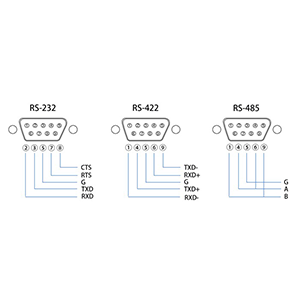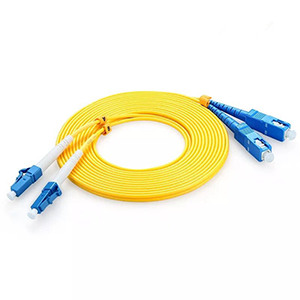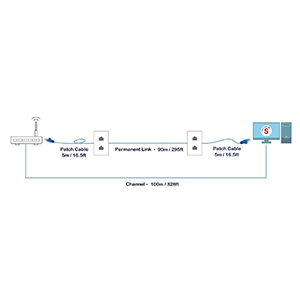RJ45 and RS-232, as common connection interfaces, play an important role in communication equipment. This article will provide an in-depth analysis of the similarities and differences between the two. We will first introduce the basic overview of the RJ45 interface, including its physical structure and application in Ethernet. Next, we will define the principles and main features of the RS-232 interface, and explain its application scenarios in serial communications.
Subsequently, we will compare the differences between the two in terms of interface shape, pin arrangement, transmission rate, etc. In addition, we will also discuss the interconnection issues of RJ45 and RS-232 in practical applications and introduce related conversion solutions. Finally, we will analyze the applicability of the two interfaces according to different needs and provide practical suggestions when choosing them.

Basic overview of RJ45 interface
Let me introduce you to the basic situation of the RJ45 interface: The RJ45 interface is a common network interface that uses an 8-core RJ45 crystal head to connect twisted pairs. The RJ45 interface is mainly used for Ethernet connections. The advantages of the RJ45 interface are small size, easy installation and maintenance.
Physical structure and application fields of RJ45 interface:
1. Physical structure:
- The RJ45 interface adopts an 8pin/8slot design, and the plug and socket structures are complementary.
- Each pin is used to transmit or receive data signals, or provide power supply.
- The cable uses 4 pairs of 8-core unshielded twisted pair (UTP) or shielded twisted pair (STP).
2.Application fields:
- RJ45 interface is widely used in cable-based network technologies such as Ethernet, ADSL, and PoE.
- Wired interfaces used to connect network devices such as PCs, switches, routers, APs, etc.
- Commonly used in homes, enterprises, data centers and other scenarios.
The role of RJ45 in Ethernet and other networks:
1. Ethernet connection
- The RJ45 interface is an Ethernet standard physical interface used to connect network devices.
- RJ45-based connections can realize data transmission between computers, switches and other devices.
2. Network expansion
- The RJ45 interface uses cables to extend the network from one location to another.
- By connecting to a switch or router, the RJ45 interface realizes the construction of a LAN.
3. Power supply support
- Some RJ45 interfaces support PoE (Power over Ethernet) function.
- The RJ45 interface not only transmits data, but also provides power supply to the device.
- Apply to IP network cameras, wireless AP and other devices that require remote power supply.
4. Unification of standards
- The RJ45 interface is one of the physical layer specifications of network standards such as Ethernet.
- Uniform physical interface standards ensure interoperability between devices from different manufacturers.
In short, the RJ45 interface, as the standard physical interface for cable networks such as Ethernet, plays a key role in network connection, expansion and power supply, and is an indispensable and important part of today’s network technology.
Basic overview of RS-232 interface
Let me give you a basic overview of the RS-232 interface: The RS-232 interface is a serial communication interface that uses a DB9 or DB25 connector to connect devices. The RS-232 interface is mainly used for communication between computers and peripheral devices. The advantages of the RS-232 interface are simplicity, ease of use, and low cost.
Principles and main features of RS-232 interface:
1.Principle:
- RS-232 is an asynchronous serial communication interface standard developed by the Electronic Industries Association (EIA).
- It converts digital signals into analog voltage signals and performs asynchronous data transmission between two devices.
2. Main features:
- Use unbalanced voltage signals, usually within the voltage range of ±5V to ±15V.
- Using a single signal line for two-way communication requires a separate ground wire as a signal reference.
- The transmission distance is generally within 15 meters, and the maximum transmission rate is 19.2kbps.
- Usually use a DB-9 or DB-25 type serial interface connector.
Application scenarios of RS-232 in serial communication:
1. Computer peripheral device connection
- Connect the computer to peripheral devices such as printers, plotters, and modems.
- Realize data exchange and control between these devices and computers.
2. Industrial control equipment connection
- Used to connect PLC, CNC, test instruments and other industrial control equipment.
- Enable data communication and monitoring between these devices and computers or controllers.
3. Embedded system serial communication
- Embedded systems such as microcontrollers and MCUs often use RS-232 for debugging and data transmission.
- Such as communication between the microcontroller system and the PC, program downloading, etc.
4. Medical equipment connection
- Medical monitors, inspection equipment, etc. often use RS-232 for data transmission.
- Realize the interconnection and data exchange between these devices and medical information systems.
In short, RS-232, as a classic serial communication interface standard, is widely used in fields such as computer peripherals, industrial control, embedded systems, and medical equipment. It is an important method in serial communication. Physical interface technology.
Similarities and differences between RJ45 and RS-232
Let me compare the similarities and differences between the RJ45 interface and the RS-232 interface for you: RJ45 and RS-232 are both common network interfaces, but there are some differences between them. The RJ45 interface uses an 8-core RJ45 crystal head to connect to the twisted pair, while the RS-232 interface uses a DB9 or DB25 connector to connect to the device. The RJ45 interface is mainly used for Ethernet connections, while the RS-232 interface is mainly used for communication between computers and peripherals. The RJ45 interface has a higher transmission rate, while the RS-232 interface has a longer transmission distance.
Differences at the physical level:
1.Interface shape
- The RJ45 interface adopts a rectangular plug and socket structure with 8 pins/slots.
- RS-232 interface often uses DB-9 or DB-25 type serial connector, with 9 or 25 pins.
2.Pin arrangement
- The RJ45 pin arrangement sequence is 1-8, and the pin numbers are from left to right.
- The RS-232 pin arrangement is relatively complex, and the pin numbers of different models of connectors are different.
3. Connector size
- The RJ45 interface is smaller, and the plug size is about 13.5mm×8mm.
- The DB-9 and DB-25 connectors of the RS-232 interface are larger in size, 19.4mm×31.8mm and 44.5mm×51.8mm respectively.
Differences at the functional level:
1.Transmission rate
- The RJ45 interface supports Ethernet transmission rates of 10/100/1000Mbps.
- The transmission rate of the RS-232 interface is relatively low, generally between 300bps and 115.2kbps.
2. Signal type
- RJ45 uses digital level signals for Ethernet data transmission.
- RS-232 uses analog voltage signals (±5V to ±15V) for serial communication.
3. Communication methods
- RJ45 realizes full-duplex Ethernet communication, and data can be sent and received at the same time.
- RS-232 usually uses asynchronous serial communication, and data needs to be sent and received in turns.
4.Transmission distance
- The transmission distance of RJ45 is generally within 100 meters, which is suitable for LAN applications.
- The transmission distance of RS-232 is usually within 15 meters, which is suitable for short-range serial connections.
In short, RJ45 and RS-232, as two common interface technologies, have obvious differences in physical structure and functional characteristics. RJ45 is more suitable for high-speed digital communication over Ethernet, while RS-232 is more suitable for low-speed analog signal transmission between serial devices. Understanding the similarities and differences between the two can help in the correct selection and application of these two interface technologies.
Compatibility and conversion options
Let me introduce to you the connection compatibility issues of RJ45 and RS-232 in practical applications and the corresponding conversion solutions: RJ45 and RS-232 interfaces can be converted, and you can use an RJ45 to RS-232 converter. Convert. The RJ45 to RS-232 converter can convert the signal of the RJ45 interface into the signal of the RS-232 interface and vice versa. The RJ45 to RS-232 converter can be used to connect devices using different interfaces.
Interconnection issues between RJ45 and RS-232:
1.Interface mismatch
- The physical connection structures of the RJ45 interface and the RS-232 interface are completely different and cannot be connected directly.
- Conversion equipment or cables are required to interconnect the two.
2. Signal incompatibility
- RJ45 uses digital level signals, RS-232 uses analog voltage signals, and cannot directly exchange data.
- Signal level conversion is required to ensure that data can be transmitted correctly.
3. The functions do not correspond
- RJ45 is used for Ethernet connection, and RS-232 is used for serial communication. Their functions and applications are different.
- You need to consider the needs of the application scenario and choose an appropriate conversion solution.
RJ45 to RS-232 conversion plan:
1.RJ45 to RS-232 converter
- This converter integrates a signal level conversion circuit and can convert RJ45 signals into RS-232 signals.
- Usually RJ45 interface input and DB-9 or DB-25 serial port output are used to realize the physical connection between the two.
2.RJ45 to RS-232 network cable
- This kind of network cable has a built-in signal conversion circuit, with an RJ45 on one end and an RS-232 serial port on the other.
- It can directly replace standard network cables to realize the interconnection between RJ45 devices and RS-232 devices.
3. Serial server
- This type of equipment integrates an RJ45 Ethernet interface and an RS-232 serial port to enable interconnection between the two.
- Convert the data of the RJ45 device into a format that can be recognized by the RS-232 device through network protocols (such as TCP/IP).
Examples of application scenarios:
- Connect an Ethernet switch to older industrial control equipment that still uses RS-232 serial ports.
- Connect new network cameras to surveillance systems that only have an RS-232 serial port.
- Connect the embedded device with RJ45 network port to the debugging terminal with only RS-232 interface.
In short, the incompatibility between RJ45 and RS-232 interfaces can be solved through converters, conversion cables or serial servers. These conversion solutions can effectively connect two different types of devices to meet the needs of practical applications.
Considerations in selecting application scenarios
Let me analyze for you the considerations for choosing RJ45 interface or RS-232 interface in different application scenarios: RJ45 and RS-232 interfaces have their own advantages and disadvantages in different application scenarios. The RJ45 interface is suitable for high-speed, short-distance network connections, while the RS-232 interface is suitable for low-speed, long-distance device connections. When selecting an interface, factors such as transmission rate, transmission distance, and device type need to be considered.
Analyze the applicability of the two based on application requirements:
1.Transmission rate requirements
- If high-speed Ethernet transmission is required, the RJ45 interface is more suitable and can support 10/100/1000Mbps.
- If only lower speed serial communication is required, the RS-232 interface can also meet the requirement, up to 115.2kbps.
2.Transmission distance requirements
- The RJ45 interface is suitable for LAN environments, and the transmission distance is generally within 100 meters.
- RS-232 interface is suitable for short-distance connection, and the transmission distance is generally within 15 meters.
3. Signal type requirements
- If you need to use digital level signals for communication, the RJ45 interface is more suitable.
- If you need to use analog voltage signals for communication, the RS-232 interface is more suitable.
4. Application scenarios
- RJ45 interface is widely used in network-based connection scenarios such as Ethernet and PoE.
- RS-232 interface is mainly used in serial communication scenarios such as computer peripherals and industrial control equipment.
Practical suggestions for choosing RJ45 or RS-232 interface:
1. Clarify application requirements
- First, determine the appropriate interface based on the required transmission rate, distance, signal type and other requirements.
2. Consider compatibility
- If you need to interconnect with existing equipment, make sure the selected interface can match it.
- Converters or conversion cables can be used to interconnect different interface types.
3. Focus on flexibility
- If you may need to upgrade or expand the system in the future, you can choose the RJ45 interface with wider applications.
- This can better adapt to technological development and avoid frequent changes in interface types.
4. Pay attention to cost factors
- The hardware cost of the RS-232 interface is usually lower, but it requires special cables and converters.
- The hardware cost of the RJ45 interface is relatively high, but standard network cables can be used directly.
To sum up, when choosing between RJ45 and RS-232 interfaces, you need to comprehensively consider various factors such as application requirements, compatibility, flexibility, and cost to choose the most suitable interface solution. Only in this way can the high performance, stability and scalability of the system be ensured.
Summary
RJ45 and RS-232 are the connection interfaces between communication devices, and their selection and application directly affect the interconnection and interoperability between devices. Our company has long been focused on the R&D and production of network communication equipment and its supporting products, and has accumulated rich industry experience. Our RJ45 and RS-232 series interface products not only reach industry-leading levels in terms of physical size and transmission performance, but also provide reliable conversion solutions for their compatibility.
Whether you need an Ethernet connection based on RJ45 or serial communication based on RS-232, we can tailor the optimal solution for you. At the same time, our technical team is ready to provide you with professional guidance and after-sales support to ensure that your communication equipment can be interconnected efficiently and stably. Contact us today to learn more details about RJ45 and RS-232 interfaces.
RJ45 and RS-232 interface FAQ
RJ45 is a type of electrical connector commonly used for Ethernet network connections, typically found on Ethernet cables, network switches, and network interface cards (NICs).
RS-232 is a serial communication interface standard that was widely used for connecting computers, modems, and other digital devices, typically using a 9-pin or 25-pin D-sub connector.
RJ45 is primarily used for Ethernet data networking, while RS-232 is used for serial data communication between various digital devices.
RJ45 connectors have 8 pins, while RS-232 connectors typically have either 9 pins or 25 pins, and the physical dimensions and pinout configurations are different.
RJ45 can support a wide range of Ethernet data rates, from 10 Mbps to 10 Gbps and beyond, while RS-232 is typically limited to lower data rates, generally up to 115.2 kbps.
RJ45 Ethernet connections are typically limited to 100 meters, while RS-232 connections can extend up to 15 meters or more, depending on the data rate and cable quality.
RJ45 uses balanced, differential signaling, while RS-232 uses single-ended, unbalanced signaling with different voltage levels and polarity.
RJ45 is widely used in Ethernet networks, including local area networks (LANs), while RS-232 is commonly found in industrial equipment, serial printers, and older computer peripherals.
No, RJ45 and RS-232 interfaces are not compatible and cannot be directly connected without the use of a protocol converter or adapter.
While RJ45 remains the dominant interface for Ethernet, RS-232 is becoming less common as newer, higher-speed serial interfaces, such as USB and Ethernet-based alternatives, have become more widely adopted.





